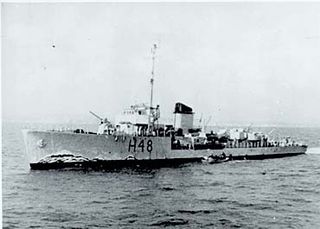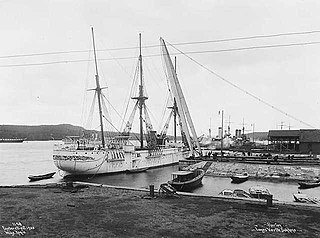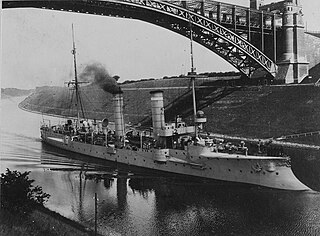
The Royal Norwegian Navy is the branch of the Norwegian Armed Forces responsible for naval operations of Norway. As of 2008, the Royal Norwegian Navy consists of approximately 3,700 personnel and 70 vessels, including 4 heavy frigates, 6 submarines, 14 patrol boats, 4 minesweepers, 4 minehunters, 1 mine detection vessel, 4 support vessels and 2 training vessels. It also includes the Coast Guard.

HMS Bristol (D23) was a Type 82 destroyer, the only vessel of her class to be built for the Royal Navy. Bristol was intended to be the first of a class of large destroyers to escort the CVA-01 aircraft carriers projected to come into service in the early 1970s but the rest of the class and the CVA-01 carriers were cancelled as a result of the 1966 Defence White Paper which cut defence spending.

HNoMS Tordenskjold, known locally as Panserskipet Tordenskjold, was a Norwegian coastal defence ship. She, her sister ship, Harald Haarfagre, and the slightly newer Eidsvold class were built as a part of the general rearmament in the time leading up to the events in 1905. Tordenskjold remained an important vessel in the Royal Norwegian Navy until she was considered unfit for war in the mid-1930s.

HNoMS Draug was the lead ship of the three-ship Draug class of destroyers built for the Royal Norwegian Navy in the years 1908–1913. The four-stacked destroyer was kept in service long after she was obsolete, and took part in the defence of Norway during the German invasion in 1940.

HNoMS Garm was the third destroyer built for the Royal Norwegian Navy, and was a Draug class destroyer. Garm was constructed several years after her two sister ships, but to the same plans. She was built at the naval shipyard in Horten, with yard number 107.

The Sleipner class was a class of six destroyers built for the Royal Norwegian Navy from 1936 until the German invasion in 1940. The design was considered advanced for its time, and it was the first class of vessels for the Norwegian Navy that used aluminium in the construction of the bridge, the mast and the outer funnel. Extra strength special steel was used in the construction of the hull. Unlike the earlier Draug class the Sleipner class had comparatively good capabilities in both main guns, anti-aircraft artillery and anti-submarine weapons. The class was named after Sleipnir, the eight-legged horse of Odin.
The HNoMS Gor was a Gor-class Rendel gunboat built for the Royal Norwegian Navy at Karljohansvern Naval Yard in Horten in 1884. She was one of a class of two gunboats - the other ship in her class being Tyr. The Gor and Tyr can be seen as improved Vale-class gunboats.
HNoMS Tyr was a Gor-class Rendel gunboat built for the Royal Norwegian Navy at Karljohansverns Verft Naval Yard in Horten. She was laid down in 1884 and launched in 1887 with build number 67. Tyr was one of a class of two gunboats - the other ship in her class being HNoMS Gor. Gor and Tyr can be seen as improved Vale-class gunboats, of 290 tons instead of the 250 tons standard for that class.

HNoMS Ellida was a 1. class gunboat built for the Royal Norwegian Navy. Like the other Norwegian gunships of her era, she carried a reasonable heavy armament on a diminutive hull. A distinct feature of Ellida was that her funnel could be raised and lowered as needed. The vessel was built at the Naval Yard at Horten, and had yard number 59.

HNoMS Olav Tryggvason was a minelayer that was built by the naval shipyard at Horten in the early 1930s with the yard number 119. She served in the Royal Norwegian Navy until captured by the Germans in 1940. The Germans renamed her first Albatros II, and a few days later Brummer. She was wrecked in a British bombing raid in northern Germany in April 1945.

HNoMS Frithjof was a 1. class gunboat (built for the Royal Norwegian Navy. Like the other Norwegian gunboats of her era, she carried a heavy armament on a diminutive hull. The vessel was built at the Naval Yard at Horten, and had yard number 76.

HNoMS Æger was a Sleipner-class destroyer launched at Karljohansvern naval shipyard in Horten in 1936. The Sleipner class was part of a Norwegian rearmament scheme started as war became ever more likely in the 1930s. When the Germans invaded Norway on 9 April 1940, Æger intercepted and sank the clandestine German supply ship Roda. She was shortly afterwards attacked and sunk by German bombers, claiming two of the attacking aircraft with her anti-aircraft armament before being taken out of action by a heavy bomb. This makes her the first naval ship sunk by aeroplane in hostility.

HNoMS Sleipner was a destroyer commissioned into the Royal Norwegian Navy in 1936. The lead ship of the Sleipner class, she gained near-legendary status in Norway by enduring over two weeks of intense air attack by Luftwaffe bombers following the 9 April 1940 invasion of Norway. After the resistance in South Norway started unravelling she made her way over the North Sea to continue the fight against the Germans from exile. After serving as a convoy escort along the coast of the United Kingdom, she was decommissioned in 1944. She was recommissioned in 1948 after being converted to a frigate. Along with her surviving sister ships she was sold for scrapping in 1959.

HNoMS Gyller was a Sleipner-class destroyer commissioned into the Royal Norwegian Navy in 1938. Along with the other Sleipner-class vessels in commission at that time, she took part in protecting Norwegian neutrality during the Second World War. After initially serving in the far north during the Finno-Soviet Winter War, she was redeployed to Southern Norway, escorting ships through Norwegian territorial waters. When the Germans invaded Norway on 9 April 1940, she was docked at Kristiansand. After taking part in the defence of the port city, she was captured intact by the invading Germans. Renamed Löwe, she sailed with Nazi Germany's Kriegsmarine for the duration of the war.

HNoMS Odin was a Sleipner-class destroyer that entered service with the Royal Norwegian Navy in 1939. She and the other Sleipner-class vessels were built as part of a Norwegian rearmament scheme in the last years leading up to the Second World War. In 1940, she had taken part in protecting Norwegian neutrality, before being caught in the German invasion of Norway on 9 April 1940. After fighting the invasion forces at Kristiansand, she was captured and pressed into Kriegsmarine service for the duration of the war. After the end of the war, she was returned to Norway. In 1948, she and her surviving sister ships were converted to frigates and remained in service until sold for scrapping in 1959.

The Trygg class was the third and last class of torpedo boats to be built for the Royal Norwegian Navy. The three Trygg ships were constructed from 1919 to 1921 at Moss Verft in Moss (Trygg) and Horten naval yard.

The Gorgon-class monitors were a class of monitors in service with the Royal Navy during World War I. Gorgon and her sister ship Glatton were originally built as coastal defence ships for the Royal Norwegian Navy, as HNoMS Nidaros and HNoMS Bjørgvin respectively but requisitioned for British use. Gorgon commissioned first, in June 1918 and bombarded German positions and other targets in Occupied Flanders. She fired the last shots of the war by the Royal Navy into Belgium on 15 October 1918. She was offered for sale after the war, but was used as a target ship when there were no takers. She was sold for scrap in 1928. Glatton was destroyed by a magazine explosion only days after she was completed in September 1918 while in Dover Harbour. She remained a hazard to shipping until the wreck was partially salvaged and the remains moved out of the way during 1925–26.

SMS Medusa was a member of the ten-ship Gazelle class of light cruisers that were built for the German Kaiserliche Marine in the late 1890s and early 1900s. The Gazelle class was the culmination of earlier unprotected cruiser and aviso designs, combining the best aspects of both types in what became the progenitor of all future light cruisers of the Imperial fleet. Built to be able to serve with the main German fleet and as a colonial cruiser, she was armed with a battery of ten 10.5 cm (4.1 in) guns and a top speed of 21.5 knots. Medusa served in all three German navies—the Kaiserliche Marine, the Reichsmarine of Weimar Germany, and the Kriegsmarine of Nazi Germany—over the span of over forty years.
HNoMS Tor was a Sleipner-class destroyer of the Royal Norwegian Navy that was launched in September 1939. She was under outfitting and testing when Nazi Germany invaded Norway on 9 April 1940. Although scuttled by Norwegian naval personnel to prevent her from being captured by the invading forces, she was soon salvaged by the Germans and put into service with the Kriegsmarine. Under the name Tiger she served out the war as an escort and training vessel, being recovered by the Norwegians in Denmark after the German capitulation in 1945. After the war she was converted to a frigate and served until 1959.

United States Navy submarines, surface ships, and aircraft launch torpedoes, missiles, and autonomous undersea vehicles as part of training exercises. Typically, these training munitions have no warhead and are recovered from the sea and reused. Similarly, new naval weapons under development are launched at sea in performance trials. These experimental units also need to be recovered, in their case to obtain evaluation data. At various points in history, newly manufactured torpedoes were fired as a quality control measure and these, too, had to be recovered before issuing them to the fleet. The U.S. Navy has used a variety of boats to accomplish the retrieval of these test and training munitions. As their missions evolved over the last century they have been variously known as torpedo retrievers, torpedo weapon retrievers, torpedo recovery boats, range support craft, and multi-purpose craft.


















